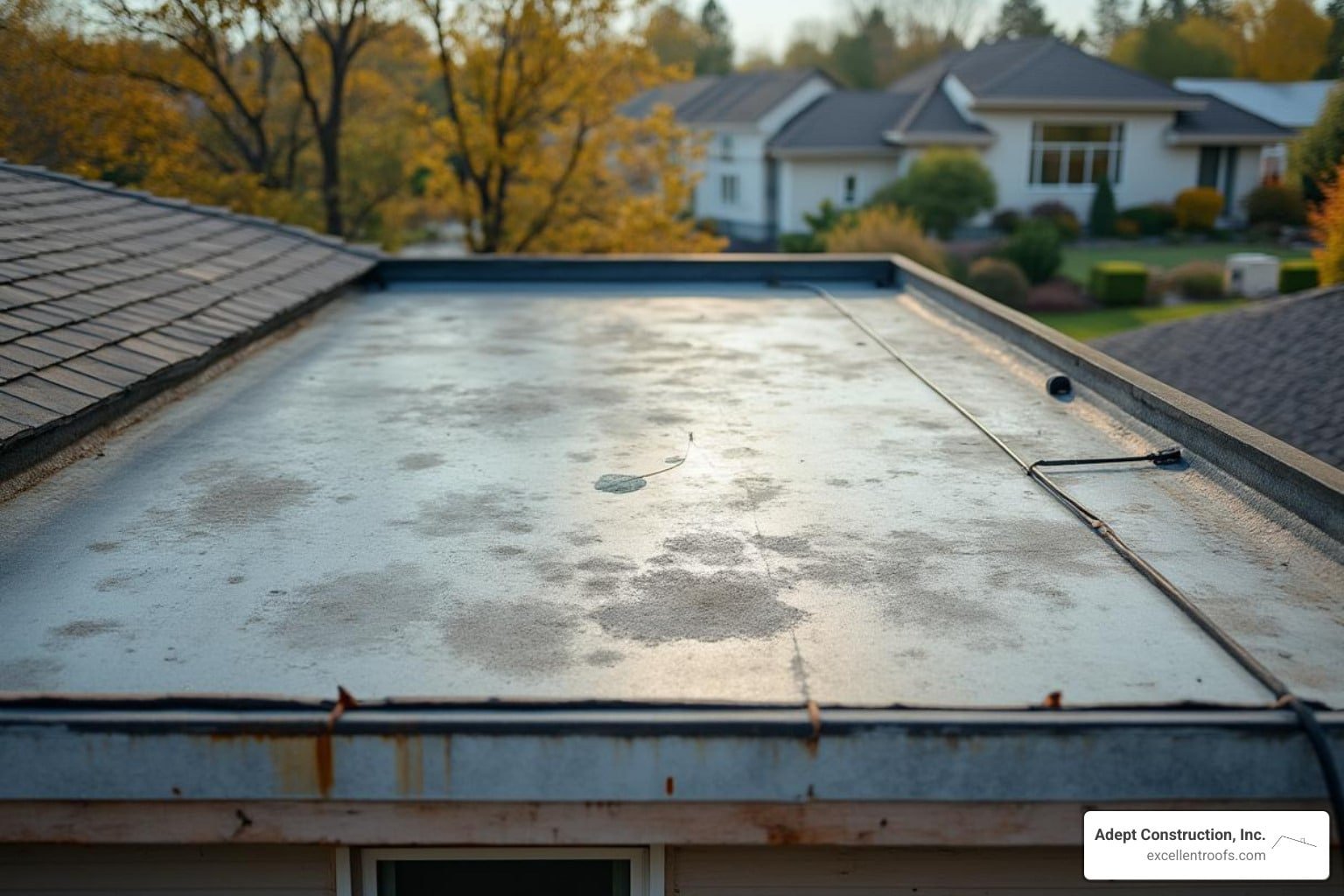
Your Guide to Flat Roof Replacement in Naperville, IL
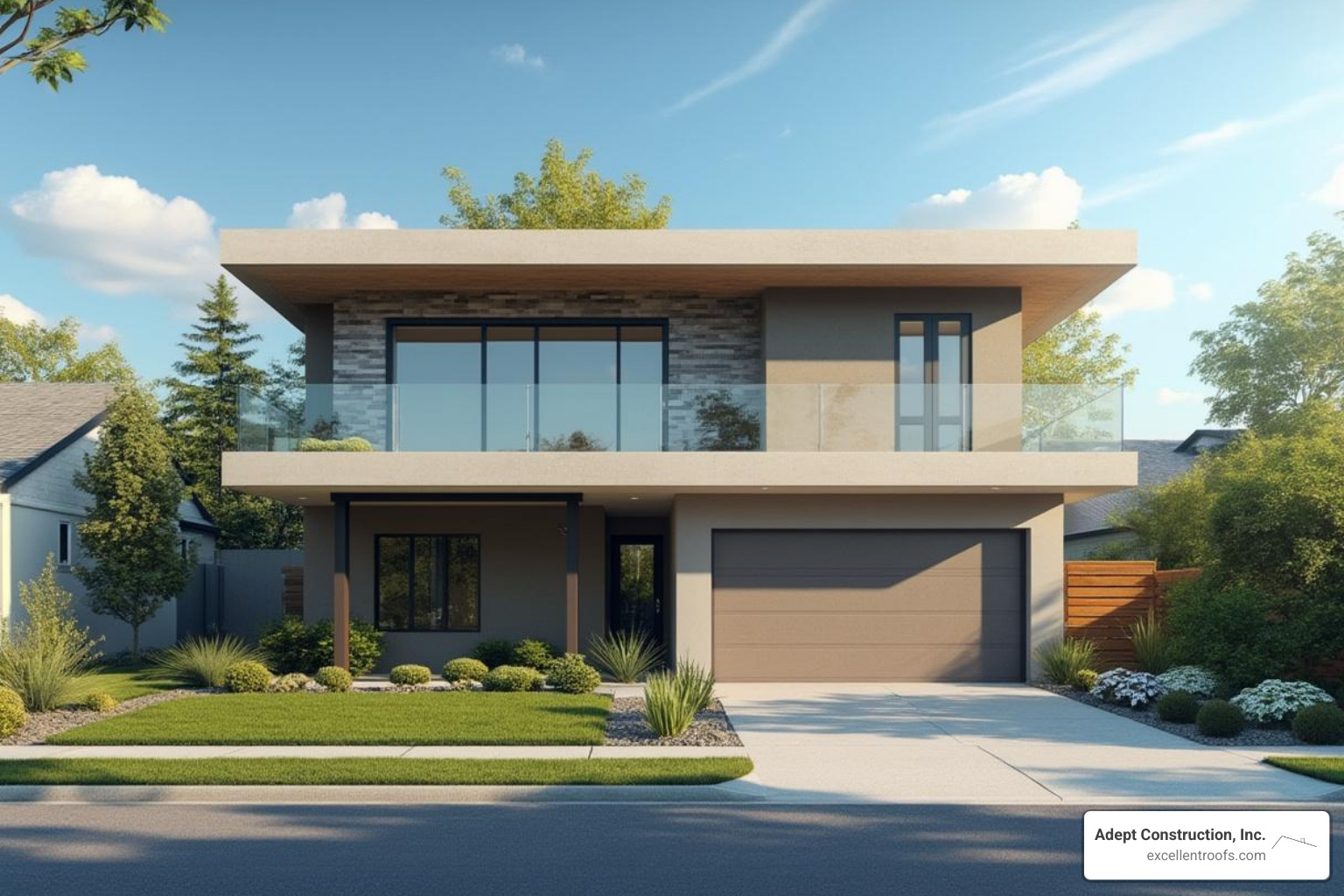
If you’re considering a replace flat roof Naperville IL project, you’re looking for answers. Here’s a quick overview of what to expect:
- When to replace: Look for standing water, cracks, blisters, or frequent leaks. If your flat roof is over 15-20 years old, it might be time.
- Common materials: Popular choices include TPO, EPDM, Modified Bitumen, and Built-Up Roofing (BUR). Each offers different benefits for your home.
- Project duration: A typical residential flat roof replacement in Naperville usually takes 1-3 days.
- Expected lifespan: A new flat roof can last 15-30 years, depending on the material and proper installation.
Flat roofs are common on many homes and commercial buildings in Naperville. They offer unique benefits but face specific challenges from our local weather, like heavy snow and extreme temperature swings. Getting expert roofing solutions from a trusted local company is key. This guide will walk you through everything about your flat roof, from signs of wear to choosing the right materials from our comprehensive flat roofing systems. Before committing to a full replacement, a thorough roof inspection in Naperville, IL can determine the extent of the damage and help you find the most affordable roofing solution in Naperville, IL.
I’m Gerald Michaels, founder and president of Adept Construction, Inc. With nearly three decades of experience, I’ve helped countless Naperville residents and businesses with their roofing needs, including complex replace flat roof Naperville IL projects. We believe in transparency and professionalism, which is why we’re fully licensed and insured. Homeowners should always verify a contractor’s credentials with the Illinois Department of Financial and Professional Regulation before starting any project.
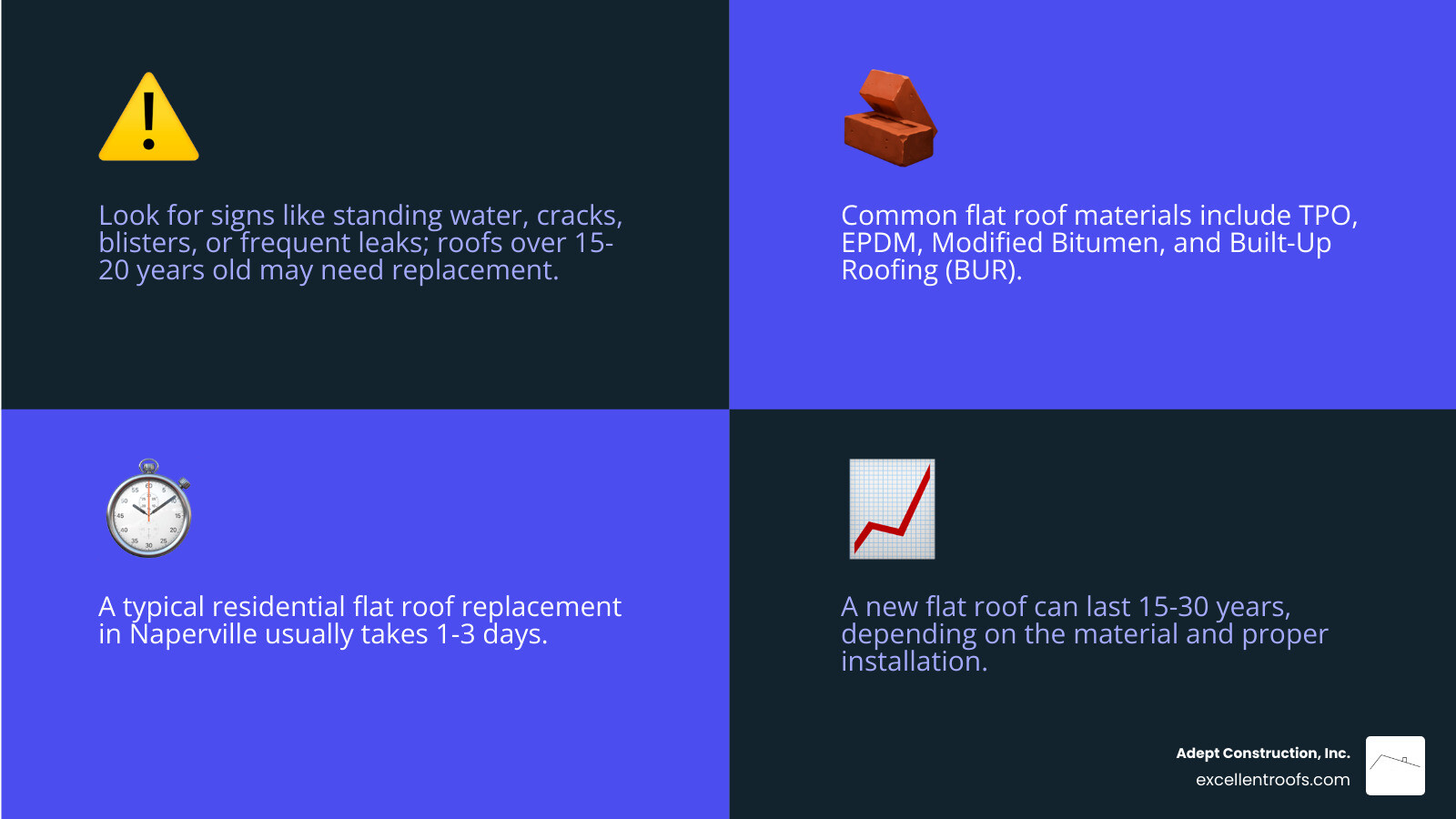
Signs Your Naperville Flat Roof Needs Replacing
Flat roofs are incredibly practical for many homes and businesses, but just like us, they sometimes need a little TLC – or a complete refresh! They’re constantly battling Naperville’s ever-changing weather, and eventually, they’ll start sending out signals that it might be time to replace flat roof Naperville IL?
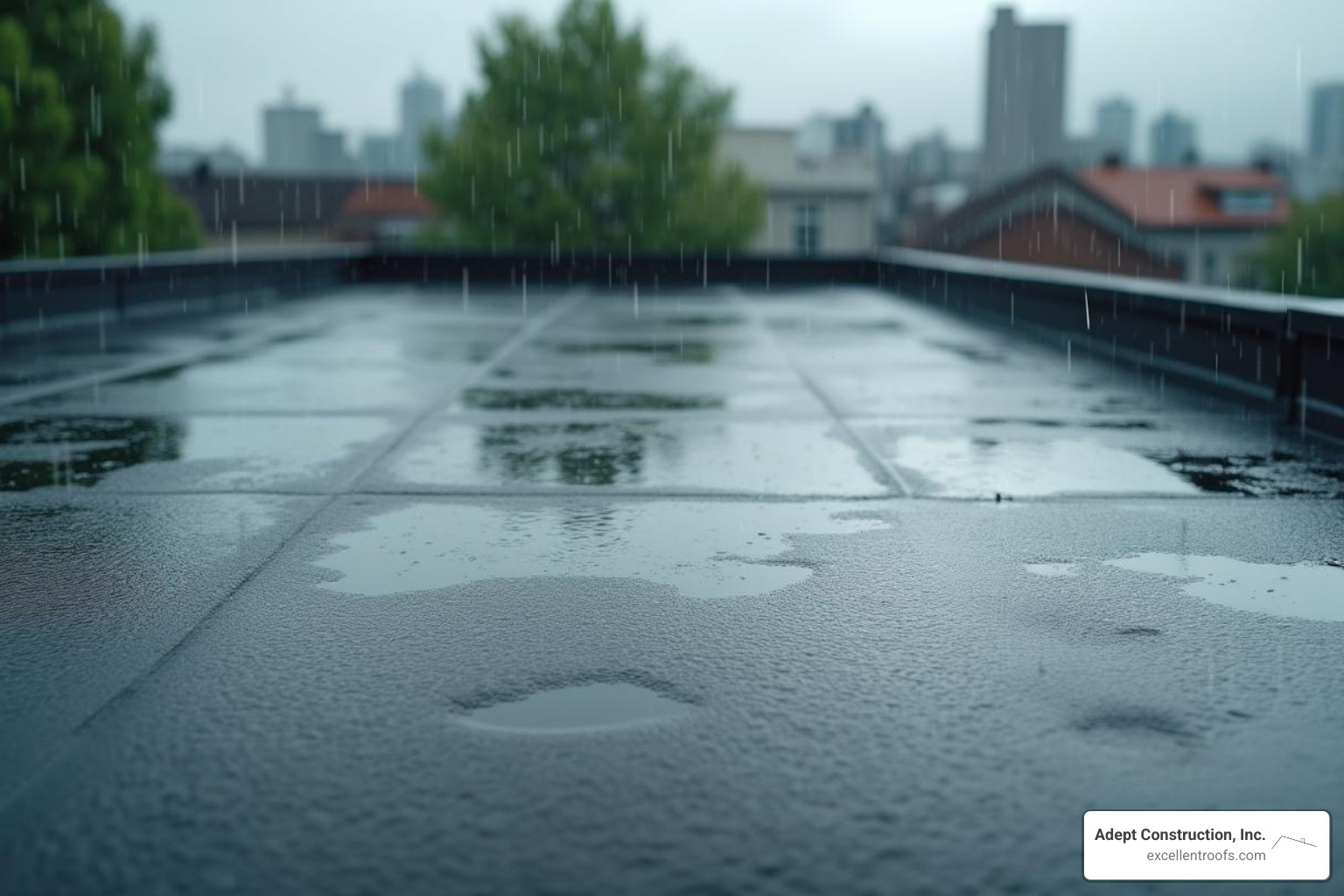
Here are the most common clues your flat roof is ready for a professional assessment:
First up is ponding water. If you see standing water on your flat roof 48 hours after it rains, that’s a red flag. Flat roofs are designed with a slight slope to drain water away, so persistent ponding suggests structural issues, incorrect installation, or sagging. This pooling water can really speed up how fast your roofing material breaks down. As one expert put it, “Flat roofs tend to hold water and wear out faster than a roof with a pitch.”
Next, keep an eye out for blistering or alligatoring. Over time, the sun’s strong UV rays and our wild temperature swings can cause the roofing material to bubble up, which we call blistering. Or, it might start to crack and look like alligator skin – that’s alligatoring. These aren’t just cosmetic issues; they mean your roof’s waterproof layer is compromised, opening the door for leaks.
Another big one is seam separation. Many flat roofs are made from sheets or layers joined together. If these seams start to pull apart, they become direct highways for water to sneak into your property. Similarly, frequent leaks are a serious warning sign. While a small, one-time leak can often be repaired, if you’re constantly patching holes, it’s like putting a band-aid on a gushing wound. A constant struggle with leaks often means the entire roofing system is failing. “Flat roofs are notorious for leaks,” so if it’s a never-ending battle, replacement might actually save you money in the long run.
Then there’s the damage you see inside your property. Interior water damage, like stains on your ceilings, bubbling paint, or damp spots, clearly shows your roof isn’t doing its job anymore. If moisture gets in and stays, you might also see mold growth. Mold isn’t just unsightly; it can cause health problems and further structural damage to your home.
Finally, consider your roof age. Even the best flat roofs have a lifespan. While some materials, like EPDM, can last up to 30 years with excellent care, if your flat roof is getting close to or has passed the 15-20 year mark, it’s definitely time to think about replacement. An older roof is simply more prone to all the issues we’ve just talked about. Naperville’s unique weather, including heavy snow and freezing-thawing cycles, puts extra stress on flat roofs, making timely replacement even more critical. When these signs pop up, we can help you in deciding between repair or replacement to find the best solution for your home.
Common Issues Leading to Flat Roof Replacement
Let’s dig a little deeper into the specific problems that often lead a flat roof to need a full replacement, rather than just a quick fix.
Ponding water, as we mentioned, isn’t just an annoyance. It adds significant weight, constantly stresses the roof membrane, and speeds up how quickly the material breaks down. It’s also a perfect breeding ground for algae and moss, which can cause even more damage. If your roof isn’t properly sloped, ponding will be a recurring problem.
You might also notice alligatoring surfaces and cracked seams. These are classic signs of material fatigue. Naperville’s extreme temperature swings cause roofing materials to expand and contract over and over again. Eventually, this makes the top layer of the roof crack and lose its flexibility. Once that protective surface is gone, water can easily get in and saturate the insulation and roof deck.
Damaged flashing is another common culprit. Flashing is the material that seals the areas around roof penetrations (like vents or skylights) and at the edges of the roof. If this flashing is cracked, pulling away, or wasn’t installed correctly, it’s a direct route for water. While you can sometimes repair isolated flashing problems, widespread damage often means there’s a bigger issue with the roof’s overall installation or its age.
And perhaps the most serious issue is moisture saturation and structural sagging. When water gets past the roof membrane, it soaks into the insulation and potentially the roof deck itself. Wet insulation loses its ability to keep your home warm or cool, and it adds a lot of weight, which can cause the roof to sag. This sagging then makes ponding water worse, creating a frustrating cycle. If your roof deck feels soft or spongy when walked on, or if you see noticeable dips, it’s a strong sign of saturation and likely means a complete overhaul is needed. For commercial buildings, these issues can be especially complex, often requiring specialized Commercial Flat Roof Repair Naperville services.
The Impact of Naperville’s Climate
Naperville is a wonderful place to live, but our unique climate definitely puts our roofs to the ultimate test! Flat roofs, in particular, face some specific challenges that can really speed up their wear and tear:
First, there’s heavy snowfall. We all love a beautiful snow day, but the sheer weight of snow on a flat roof is no joke. A single cubic foot of fresh snow can weigh 7 pounds, and wet, heavy snow can be 20 pounds or more! This constant, heavy load stresses the roof membrane and its structure, which can lead to sagging and even more ponding once the snow finally melts.
Then we have ice dams. These form when snow on the roof melts and then refreezes at the colder edges, often due to poor insulation. On flat roofs, these ice dams can trap water, stopping it from draining properly and forcing it underneath the membrane and into your home.
Our extreme temperature shifts are also a big factor. Naperville goes from scorching hot summers to freezing cold winters. This constant heating and cooling makes roofing materials expand and contract repeatedly. Over the years, this “thermal cycling” causes fatigue, cracking, and seam separation, even in the toughest materials.
Don’t forget UV exposure. The sun’s ultraviolet rays are relentlessly beating down on flat roofs. Since they have a larger, more direct surface area exposed to the sun compared to sloped roofs, UV radiation breaks down the materials over time, making them brittle and less flexible.
Finally, high winds can also be a problem. While flat roofs aren’t usually as prone to wind uplift as some pitched roofs, strong Naperville winds can still cause damage. They can lift edges, peel back seams, or even dislodge flashing, creating vulnerable spots where water can sneak in.
Understanding these specific climate pressures is super important for homeowners in serving the Naperville, IL area. If you reside just east in Downers Grove, IL, you’ll face the same roofing challenges—and our team is equally prepared to help.
Choosing the Right Material for Your Naperville Flat Roof
When it’s time to replace flat roof Naperville IL, one of the most critical decisions you’ll make is selecting the right material for your home or business. This choice isn’t just about what looks good; it deeply impacts your roof’s durability, how energy efficient your property will be, the overall cost-effectiveness of the project, and yes, even the aesthetics. We work with comprehensive flat roofing systems to ensure you get the very best fit for your needs.
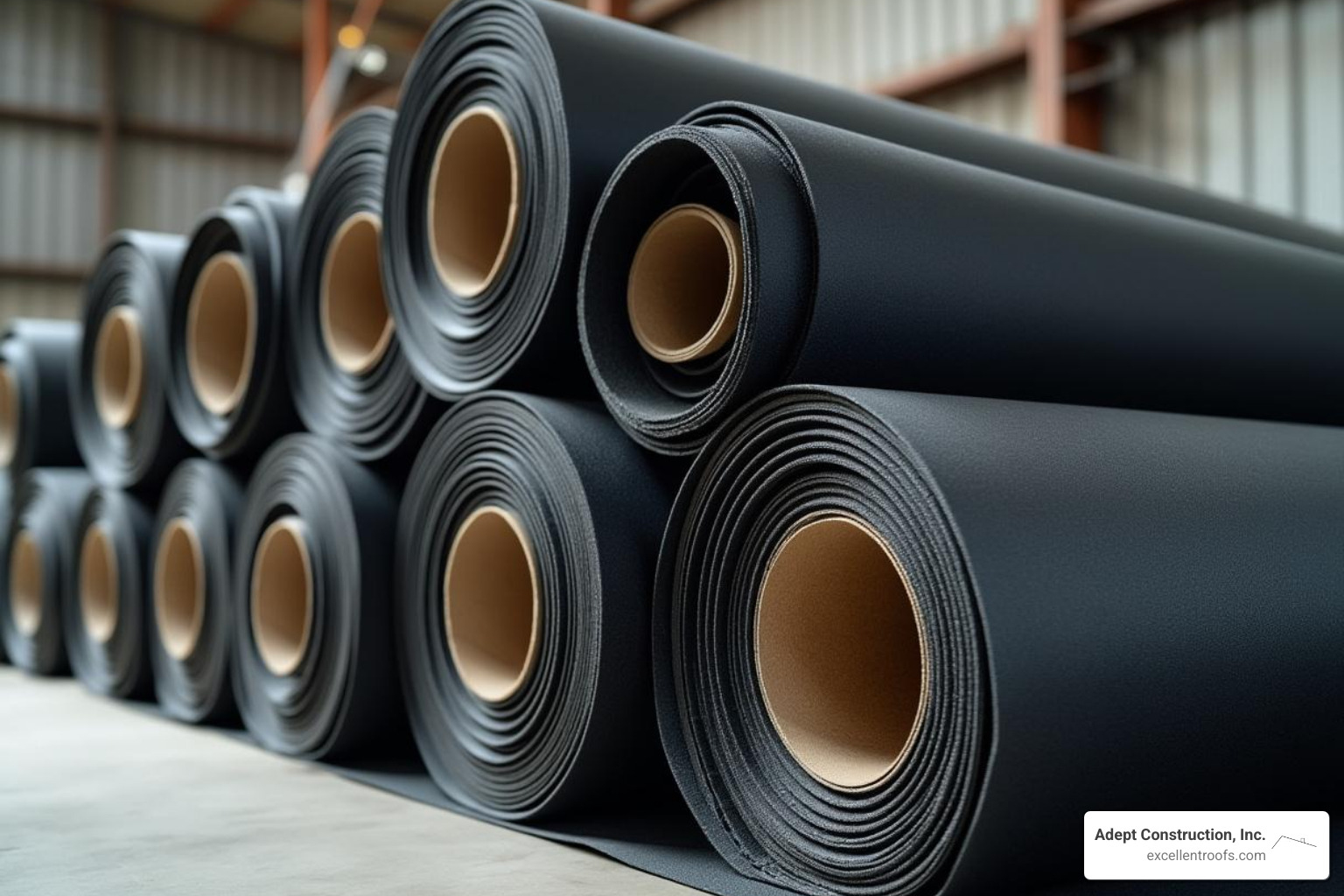
There’s truly no single “best” material that fits every situation. The ideal choice for your property depends on several factors, including your specific needs, your budget, and even the unique characteristics of your building and its usage. We also consider the installation requirements of each material to ensure a perfect, long-lasting fit.
Comparing Popular Flat Roofing Materials
Let’s take a closer look at some of the most common and reliable flat roofing materials we use in Naperville and beyond. Understanding their differences can help you make an informed decision when it’s time for your next roof replacement in Naperville IL.
| Material | Lifespan | Average Cost (per sq. ft. installed) | Pros | Cons |
|---|---|---|---|---|
| TPO (Thermoplastic Olefin) | 15-25 years | Moderate | – Highly energy-efficient (white surface reflects heat) – Heat-welded seams create a strong, monolithic membrane – Good puncture and tear resistance | – Newer material with a shorter long-term track record – Seam quality is highly dependent on installer skill – Can be less flexible in extreme cold |
| EPDM (Ethylene Propylene Diene Monomer) | 20-30 years | Low to Moderate | – Extremely durable and flexible – Proven long-term performance and weather resistance – Easy to repair | – Standard black color absorbs heat (white coating available) – Seams are glued, which can be a potential weak point – More susceptible to punctures than TPO |
| Modified Bitumen | 10-20 years | Moderate | – Multi-layer system offers superior water resistance – Very durable and resistant to foot traffic – Can have reflective granules for improved energy efficiency | – Torch-down application can be a fire hazard – Shorter lifespan compared to single-ply membranes – Seams require precise installation to prevent failure |
| PVC (Polyvinyl Chloride) | 20-30+ years | High | – Excellent durability and longevity – Highly resistant to chemicals, fire, and punctures – Heat-welded seams are exceptionally strong | – Higher upfront cost compared to TPO and EPDM – Can become brittle over time in very cold climates – Less environmentally friendly manufacturing process |
Not sure which membrane makes sense for your property? Adept Construction offers no-pressure consultations and FREE estimates—contact us today and we’ll put together a detailed quote to get your flat roof replacement moving forward with confidence.




